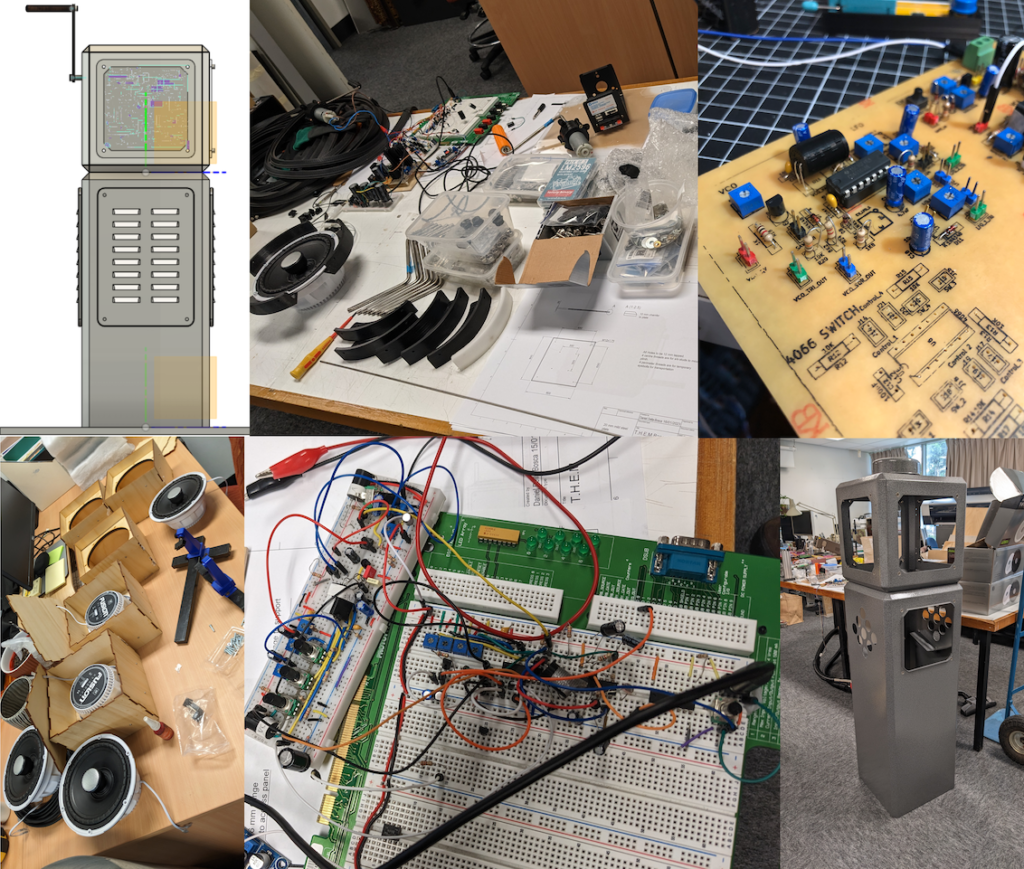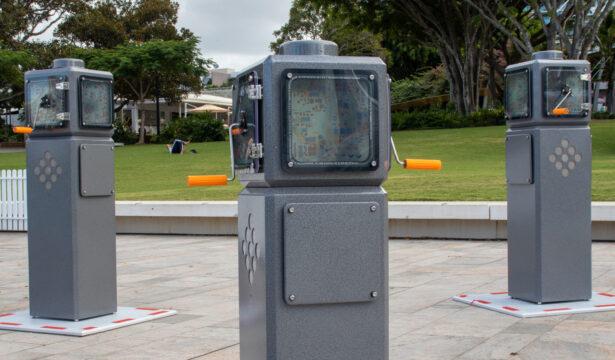T.H.E.M. (The Handmade Electric Machines) are human-powered electronic sound sculptures exploring the generation of electronic sound through the transference of energy from human kinetic action.
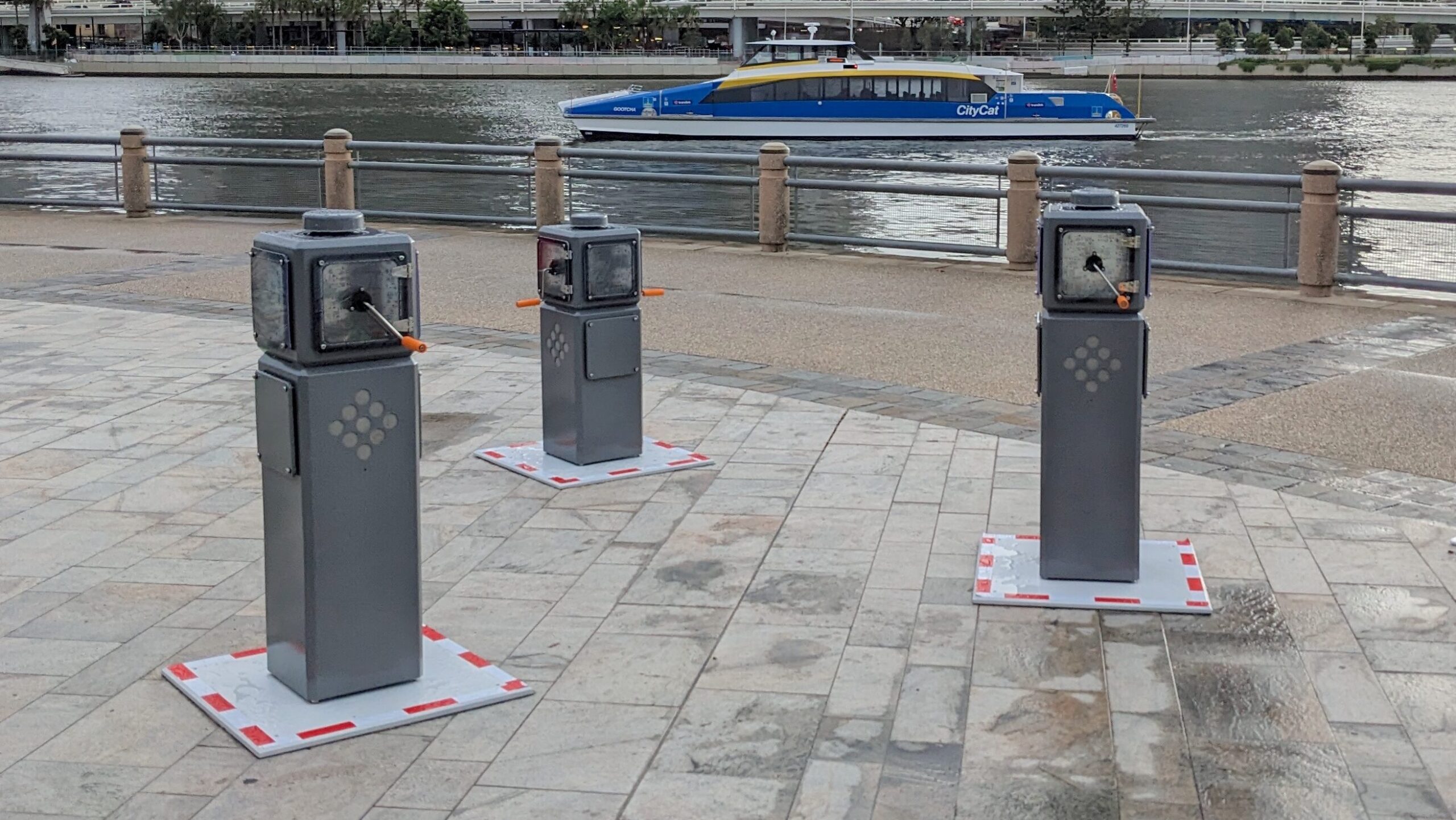
Three T.H.E.M. each comprise two different sound and light-making mechanisms to form an ensemble of electronic instruments that can be played together or separately to activate a range of sonic responses. The visual aesthetic of the specifically designed metal housing is inspired by early twentieth-century electrical enclosures and the imaginations of Nikola Tesla and Raymond Lowey. Each device is completely stand-alone, requiring only human energy to activate. Internal electronic circuitry explicitly responds to the power generated by audience participation. Bespoke handmade circuits then modulate electronic pulses of sound and light. The cranking interaction encourages participants to physically engage with the artwork and experience it in a more playful and immersive way. Each element is hand-powered, reinforcing our personal connection with electricity production at a time when societal methods of energy generation are in transition. Energy is produced by turning a crank attached to a dynamo within the device which, in turn, produces a low-voltage current powering handmade electronic circuits, amplifiers, speakers, and lights. Each device is completely stand-alone, requiring only human energy to activate. Internal electronic circuitry explicitly responds to the power generated by audience participation, which handmade circuits then transform into electronic sounds and light.
The project is designed by Daniel Della-Bosca, Andrew R. Brown, John Ferguson, and Timothy Tate, members of the Interactive Media Lab based at Griffith University. They are committed to sustainable concerns by maximising creative expression from limited materials and using small amounts of energy. Their intention is for the audience to appreciate their direct participation in generating renewable electricity and having fun being part of an ensemble of electronic instruments.
Public Exhibition
T.H.E.M. were commissioned by Curiocity Brisbane 2023 and displayed as part of the World Science Festival Brisbane from Wednesday 22 March to Sunday 2 April, 2023 in the Clem Jones Activation Space, Riverside Green, South Bank Parklands, Brisbane, Australia.
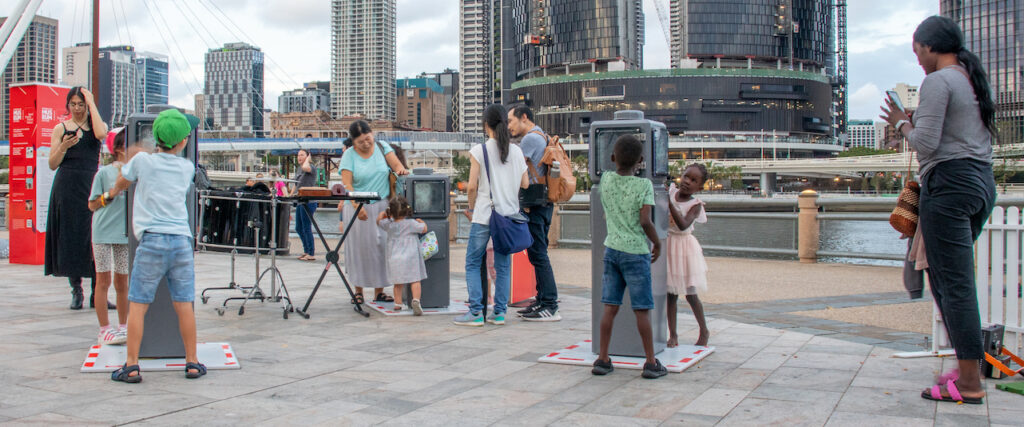
An interview on ABC Radio with Rebecca Levingston introduced T.H.E.M. to Brisbane listeners and provides some details on how they work and how they sound. An excerpt from the program isolating the section relating to T.H.E.M. is below.
Performance
Two performances of T.H.E.M. with three acoustic musicians were held as part of Curiocity Brisbane 2023. The composition was by Timothy Tate and the performers were Arthur Tan: French Horn, Yvette Ofa Agapow: Percussion, and Timothy Tate: Saxophone.
Workshops
The team lead sold-out public workshops titled “Make a Circuit SING! An Introduction to Handmade Electronic Music” during the festival. The workshops introduced participants to the electronic components used in T.H.E.M., and how they are combined to create all kinds of sounds. Workshops were targeted at beginners and those with DIY electronics experience, where participants created handmade electronic circuits that SING and learned how to play them.
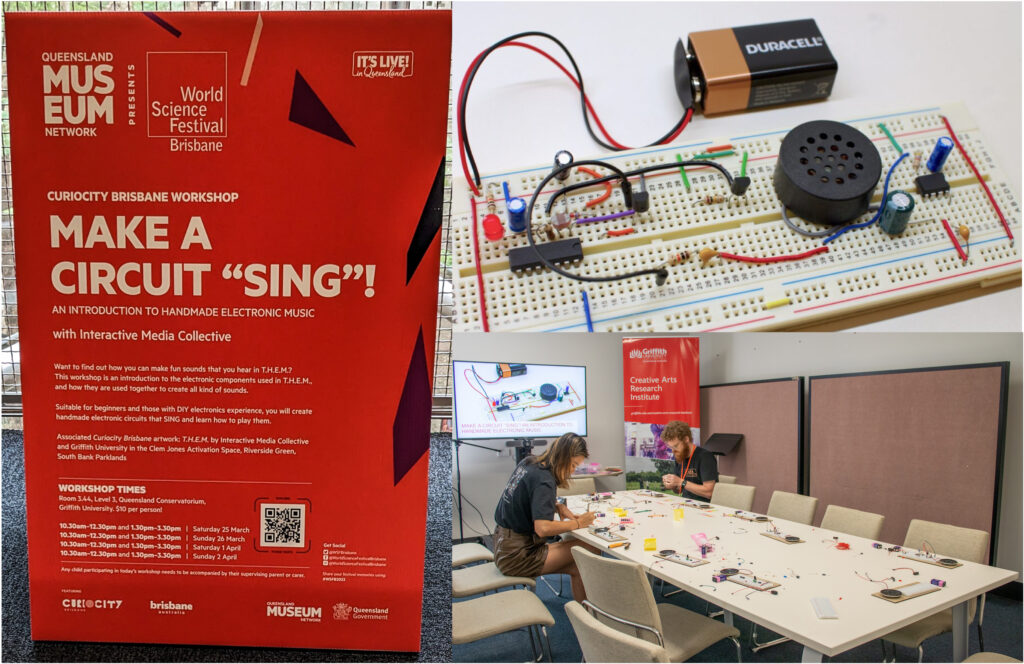
Research and Development
This research extends a tradition of hand-cranked sound machines that were popular in the late 19th and early 20th centuries. These included mechanical sound devices such as street organs and noise machines, or “intonarumori”, designed by the futurist Luigi Russolo. In an age of renewable energy transformation, a reconnection with the hand crack as a power source is timely, and T.H.E.M. reinvents the hand-cranked noise machine for the 21st century. The internal electronics are also a bespoke design by the researchers that draw on DIY electronic techniques. This work exposes audiences to handmade electronic sound in a post-digital world.
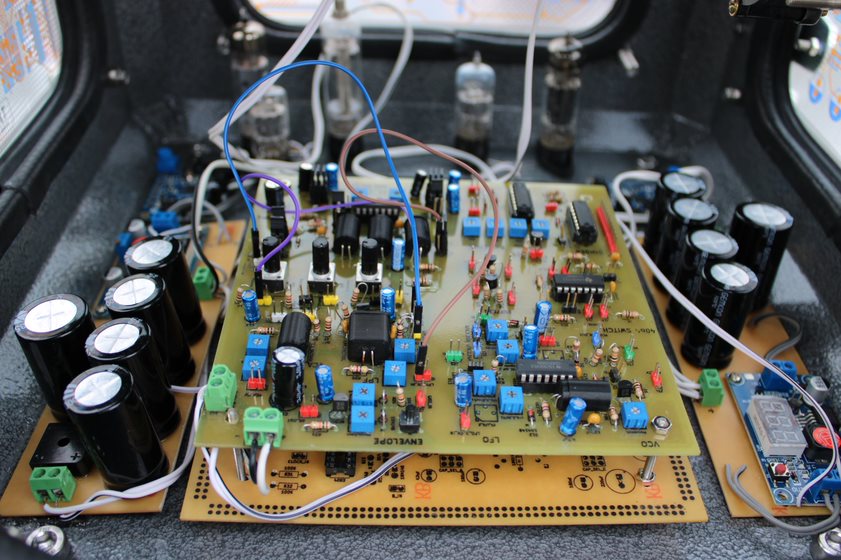
In the process of developing T.H.E.M. we investigated the utilisation of low-power and budget-friendly electronic components as the foundation for constructing frugal electronic instruments. Building on the work of Nicholas Collins and Ray Wilson we focused specifically on the use of a 40106 integrated circuit (IC) along with passive components such as capacitors, resistors, transistors, and diodes. Our goal was to create expressive, low-power, and low-cost electronic instruments that use minimal components. Drawing on decades of work in experimental electronic music we developed a range of circuit schematics as building blocks for various synthesis functions, including VCO, Noise, Summing, VCF, AR, VCA, and Amplifier, as modules for designing low-power electronic synthesizers based on the CMOS 40106 integrated circuit.
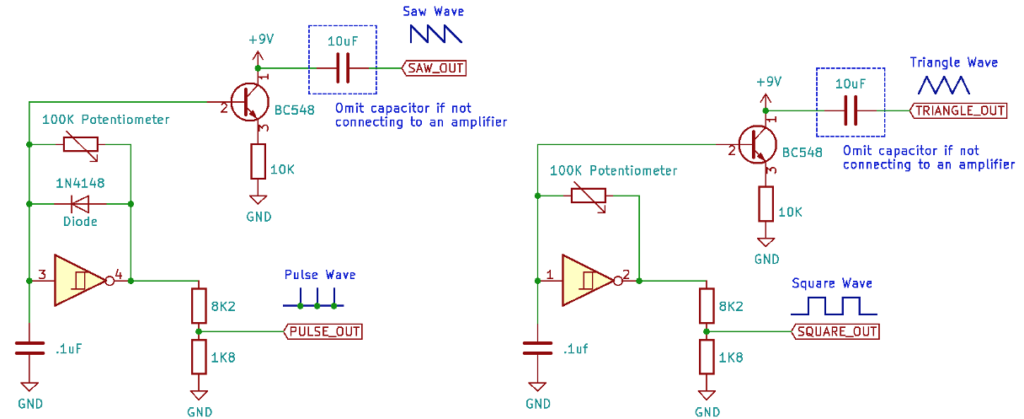
Design and Fabrication
The housing for T.H.E.M. is made of sheet aluminium with polycarbonate and aluminium panels. The structure’s design was led by Daniel Della-Bosca and inspired by the aesthetics of the futurists from the early 20th century, when electric machines were in their infancy. The housing has a somewhat anthropomorphic two-part design, with the ‘head’ containing the cranked dynamo and the audiovisual electronics. The ‘body’ contains loudspeakers and additional ballast for stability. T.H.E.M. are human scale, with two being taller and one shorter to provide visual interest and to allow for easy cranking by people of different heights. The polycarbonate panels were transparent, allowing users to peer inside to see the workings, and were printed with artwork based on the electronic circuit designs. The cranks were specially made and fittings for the dynamos, handles, and crankshaft were designed and 3D printed by the team. The aluminium cases were professionally fabricated and powder coated, and the units were hand-assembled by the team.
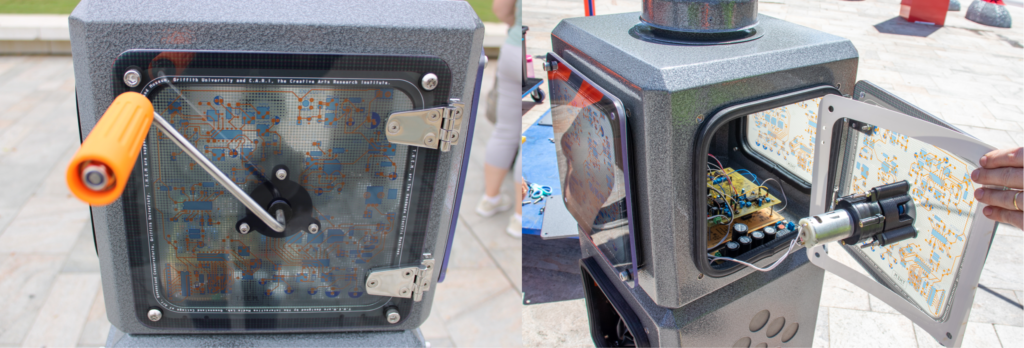
Process Documentation
The design and development of T.H.E.M required specifically-designed forms and electronics. These were developed through an iterative R&D process involving numerous sketches, drafts, prototypes, and experiments. Samples of documentation from these developmental stages are assembled in the image collage below.
